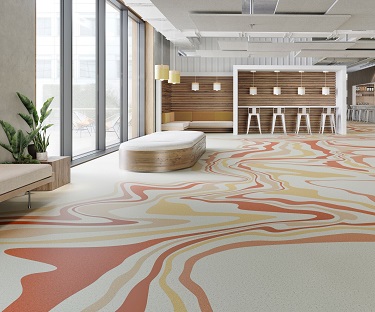 SOLON, OHIO—A worldwide leader in innovative and sustainable flooring and sports surface solutions, Tarkett North America announces a new carbon strategy that will ultimately make real changes in how the company makes its floors, reducing impact rather than offsetting it.
SOLON, OHIO—A worldwide leader in innovative and sustainable flooring and sports surface solutions, Tarkett North America announces a new carbon strategy that will ultimately make real changes in how the company makes its floors, reducing impact rather than offsetting it.
Earlier this year, Tarkett announced its Climate Roadmap for 2030, which includes a commitment to reduce greenhouse gas emissions by 30 percent across its entire value chain by 2030—in full alignment with the Paris Climate Agreement objective to limit global warming to 1.5°C. To provide full visibility into these efforts, Tarkett has been evaluated and assessed by the independent organization Science Based Targets (SBTi) to confirm its reduction targets, which includes emissions from its own activities (Scope 1) and its purchased energy (Scope 2)—as well as those arising from the rest of its value chain, from suppliers to end customers (Scope 3).
Over the last decade, Tarkett has reduced greenhouse gas emissions by 38 percent (Scope 1 and 2) through a combination of renewable electricity, closed-loop water systems, and the responsible sourcing of raw materials, and is now accelerating that progress under the 2030 Climate Roadmap. The company has recently achieved a B score by CDP, representing the second highest level of maturity a company can reach at the world’s leading climate performance platform.
‘We Want to Prove Real Impact’
“As we work to drive emissions to zero, we believe that Tarkett and every business should be held accountable for its environmental impact,” said Roxane Spears, Vice President, Sustainability, Tarkett North America. “Anyone can buy their way to carbon neutrality on paper. At Tarkett, we want to prove real impact.”
By the end of September, Tarkett North America (TNA) will have completed detailed life cycle analyses (LCAs) on its entire TNA product line. By taking this approach, the company can identify—and resolve—the root issues of what ingredients and processes are contributing to each product’s carbon footprint.
“The purchase of carbon offsets has allowed Tarkett North America to contribute to several important projects throughout the world, but it’s not an adequate long-term solution for Net Zero carbon,” said Spears. “Often, companies think of the carbon neutrality box as having been checked. Though in reality, there’s still so much more work to be done to reduce impact versus simply offsetting impact.”
Offsets Still Available to Customers
Net Zero carbon is a journey at Tarkett. Until the company reaches this goal, it will still offer to neutralize remaining carbon emissions by investing in offsets. The shift in strategy, though, means that this offset is no longer automatically applied but is available to customers who request it. Making this shift will empower Tarkett to free up resources and dedicate them to resolving root issues and eliminating actual impact.
This new carbon strategy aligns with Tarkett North America’s mission of radical transparency about its materials and operations. At Tarkett, social and environmental responsibility aren’t add-ons. They’re woven, stamped, and sealed into everything the company does. But more importantly, Tarkett doesn’t just say this, it proves it.
Tarkett’s ‘Proof in Every Step’ sustainability initiative is focused on three core pillars: Setting New Transparency Standards, Empowering the Next Step in the Value Chain, and Creating Healthier Futures. This initiative is backed by decades of proof; Tarkett North America:
- Launched the first full-scale flooring recycling program in 1994.
- Started third-party verification of environmental impacts two decades ago.
- Became phthalate-free while others were still debating phthalate safety.
Now, the company is setting tomorrow’s standards:
- 97 percent of the raw materials Tarkett uses are assessed against Cradle-to-Cradle principles for human and environmental health.
- 99 percent of Tarkett’s flooring solutions have low VOC emission levels, which are 10 times lower than the most stringent world standards.
- The company reduces its resource consumption through closed-loop water systems and renewable energy and has 14 plants that send zero waste to landfill.
- Tarkett reveals raw materials content down to 100 parts per million in every floor to provide a sustainable foundation for its customers to build on every step after.
Tarkett believes that sustainability is a collaborative effort, and net positive impacts, closed loops, and a circular economy all depend on what you start with. To learn more about how Tarkett designs floors to create healthy, safe spaces inside the walls of its own facilities and beyond, visit https://contract.tarkett.com/proofineverystep.







